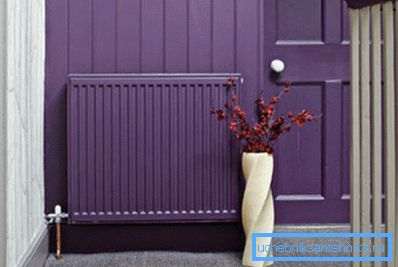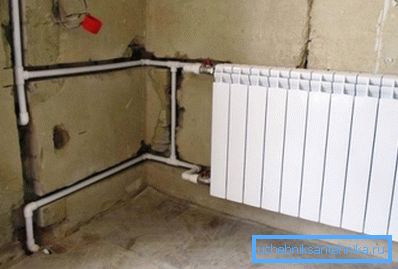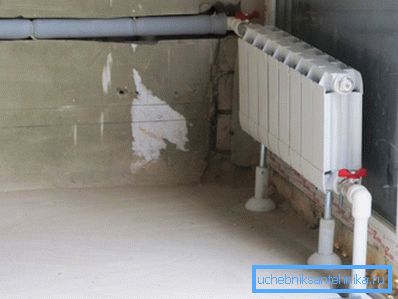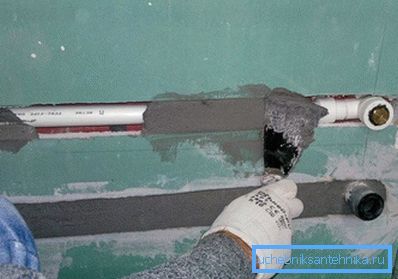How to hide the heating pipes in the interior of a
In this article we will talk about how to hide the heating pipes in the room. The topic of the hidden location of utilities is of particular interest from the beginning of the overhaul, when the pipeline and massive radiators for obvious reasons do not fit into the design of the room.
However, this problem has a simple solution, because there are several effective ways to make most of the elements in the composition of the heating system less noticeable.

So, how to hide a heating radiator and other communications, using the available materials and not attracting professional builders to work.
Actual methods

Decoration of engineering communications in a private house can be performed using the following methods:
- bookmark in plaster;
- laying in the gap between the main wall and the false-wall;
- the device box of drywall or plywood, OSB, chipboard, etc .;
- use of factory perforated boxes and casing;
- decoration of engineering communications with available materials.
Consider how to hide the heating pipes and the battery, applying each of the above methods.
Bookmark in plaster

Hidden laying of heating pipes in the interior of a country house or apartment has received the greatest popularity relatively recently, which is associated with the introduction of new technologies in the arrangement of heating systems and in the overhaul.
Laying in the wall is a universal method that is equally applicable to metal and polymer heating pipes. The instructions for the installation work does not make it particularly difficult, and therefore you can do everything with your own hands.
For work you will need the following tools and materials:
- professional wall chaser, if there is no such device, it is possible to dispense with Bulgarian grinder with a special disc for cutting concrete;
- perforator with a chisel;
- plastering supplies;
- accessories for working with pipes, depending on the type of communications chosen for the application.
Installation instructions for the following:
- we draw the direction of pipes and the place of installation of radiators on the surface of the wall;
- cut a groove in the wall (strobe) to a depth and width of 1.5 times the diameter of the heating pipe used;
- the contents of the gates are taken out using a perforator with a chisel nozzle;
- on the bottom of the grooves, every 0.5 meters we install plastic clips that will hold the pledged communications while the plaster mixture dries;
- we fasten pipes to clips, having previously made lateral branches which will come out of a wall;
- we prepare plaster mix;
Important: the type of plaster mix is selected in accordance with the type of materials used in the wall decoration.
- gradually in several layers, with a break for drying, lay the mixture in the grooves;
- after complete drying, the surface of the walls is ground to one level.

Performing these works, you can think about how to hide the radiators. Traditionally, these massive units can be left in sight and, thus, provide maximum heat release.
But, if this device does not fit into the decoration of the room, you can arrange special niches in the wall and drown the batteries in them half or full, so that only the front panel is visible.
Important: This approach to the organization of heating systems is particularly justified when the edge of the sill does not protrude beyond the wall line, but is flush with it. Moreover, the installation of batteries in a niche can be done not only under the window, but also in any other place, for example, in a narrow hallway, where a protruding radiator would create noticeable inconveniences.
Plasterboard structures

The question of how to hide the heating pipe is the most difficult to answer when conducting repairs in new construction sites, where the material used in the construction of walls or their thickness does not allow cutting out grooves. In this case, the instruction to decorate engineering communications involves the assembly of a false wall or a box of plasterboard or similar slab materials.
The advantage of this solution is the low price of the finished result, as well as the possibility of placing behind the duct not only pipes and radiators, but also low current or power wiring.
Installation work is carried out as follows:
- The crate is fastened to the wall from a special metal profile. The crate configuration is arranged in such a way that communications take place with a minimum number of bends.
- Further, on the crate built on top of pipes on self-tapping screws drywall is attached.
- Radiators make over the box. If necessary, the battery can be placed behind the drywall, but in this case the front panel should be made perforated.
- The joints between the plates we glue with a special plaster grid;
- Apply a thin layer of putty over the mesh, which, after complete drying, must be polished and painted.
Similar work can be done not with the use of drywall, but with the use of such board materials as OSB, particle board, fiberboard and plywood.
Application of factory boxes and platbands

Continuing to talk about how to hide a heating radiator and elements of the pipeline, it is impossible not to note the use of various screens, boxes and platbands.
These products are made of thin-sheet steel or heat-resistant plastic. In some cases, when decorative panels are made by hand, thin plywood is used as a production material.
There is a wide range of protective screens and platbands on the market, from which it is possible to choose those products that suit you both in terms of configuration and size, and in terms of color performance.
Depending on what products will be purchased, they can be mounted using self-tapping screws or simply hanging an accessory with special hooks on the battery.
Conclusion
Now you know how to hide the heating pipes in an apartment or in a private house. It remains to prepare the required materials, installation tools and get to work. If there are questions that require clarification, more useful information can be found in the video that can be viewed in this article.